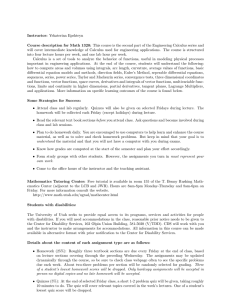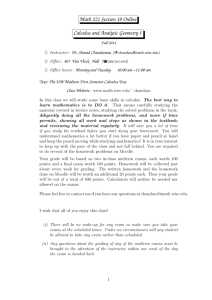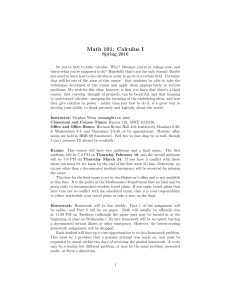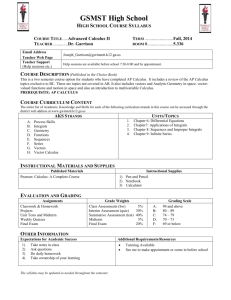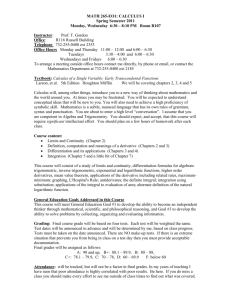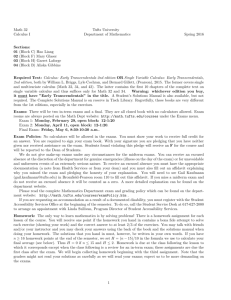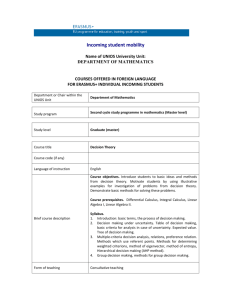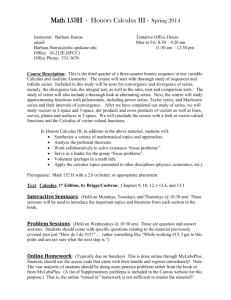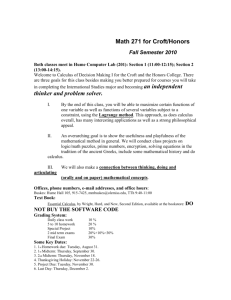MATH 4066, ADVANCED CALCULUS, FALL 2008 Location: 12:20
advertisement
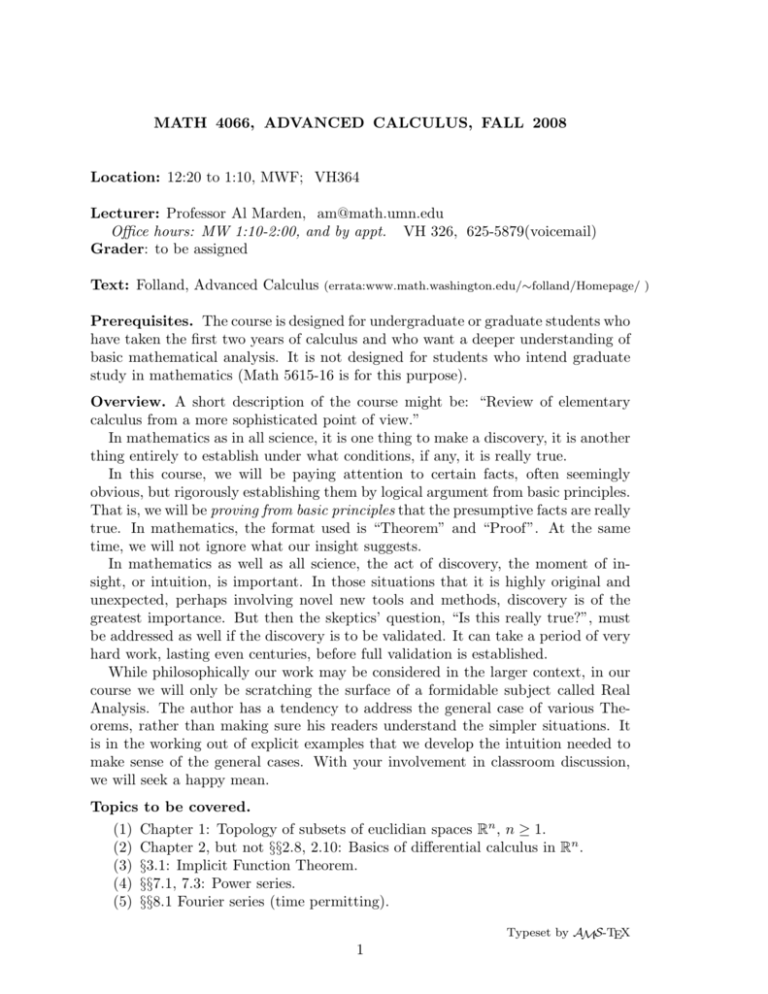
MATH 4066, ADVANCED CALCULUS, FALL 2008 Location: 12:20 to 1:10, MWF; VH364 Lecturer: Professor Al Marden, am@math.umn.edu Office hours: MW 1:10-2:00, and by appt. VH 326, 625-5879(voicemail) Grader: to be assigned Text: Folland, Advanced Calculus (errata:www.math.washington.edu/∼folland/Homepage/ ) Prerequisites. The course is designed for undergraduate or graduate students who have taken the first two years of calculus and who want a deeper understanding of basic mathematical analysis. It is not designed for students who intend graduate study in mathematics (Math 5615-16 is for this purpose). Overview. A short description of the course might be: “Review of elementary calculus from a more sophisticated point of view.” In mathematics as in all science, it is one thing to make a discovery, it is another thing entirely to establish under what conditions, if any, it is really true. In this course, we will be paying attention to certain facts, often seemingly obvious, but rigorously establishing them by logical argument from basic principles. That is, we will be proving from basic principles that the presumptive facts are really true. In mathematics, the format used is “Theorem” and “Proof”. At the same time, we will not ignore what our insight suggests. In mathematics as well as all science, the act of discovery, the moment of insight, or intuition, is important. In those situations that it is highly original and unexpected, perhaps involving novel new tools and methods, discovery is of the greatest importance. But then the skeptics’ question, “Is this really true?”, must be addressed as well if the discovery is to be validated. It can take a period of very hard work, lasting even centuries, before full validation is established. While philosophically our work may be considered in the larger context, in our course we will only be scratching the surface of a formidable subject called Real Analysis. The author has a tendency to address the general case of various Theorems, rather than making sure his readers understand the simpler situations. It is in the working out of explicit examples that we develop the intuition needed to make sense of the general cases. With your involvement in classroom discussion, we will seek a happy mean. Topics to be covered. (1) Chapter 1: Topology of subsets of euclidian spaces Rn , n ≥ 1. (2) Chapter 2, but not §§2.8, 2.10: Basics of differential calculus in Rn . (3) §3.1: Implicit Function Theorem. (4) §§7.1, 7.3: Power series. (5) §§8.1 Fourier series (time permitting). Typeset by AMS-TEX 1 2 MATH 4066, ADVANCED CALCULUS, FALL 2008 Time permitting, additional topics will be studied; the text is intended for a full year course. Coursework. Homework will be due each Friday. If you cannot attend class you can leave it in my mailbox in VH127. Late homework cannot be accepted. The grader will grade a certain subset of the assigned problems. Students who want to form a group to study and/or to do homework together are encouraged to do so. However each student must write up the solutions in his own way. You will find solutions to many of the assigned problems on Professor Voronov’s web site and perhaps elsewhere. Yet working out problems is the only way you will gain understanding of the material. Mere copying will get you a zero on the assignment. If you do get the idea of how to solve the problem from your group or another source, the honest thing is give credit for that. No points will will be taken off and you will leave a good impression. The homework will count 20% of the final grade. If you miss some homeworks or midterms with a good excuse, the final exam will be proportionally counted more. Exams: There will be two 50 minute midterm exams each counting 20% of the final grade, and a two hour final counting 40%. Many of of the midterm and final exam problems will be taken from the assigned homework. The exams will be: (1) MIDTERM I: Wednesday, October 1. (2) MIDTERM II: Wednesday, November 12. (3) FINAL EXAM: Scheduled for Monday, Dec. 15; 10:30—12:30. Assigned homework problems: Section Page Problems 1.1 8 1, 2, 5, 6 1.2 12 1, 2, 3, 4, 5 1.3 19 1, 2a, 8, 9 (see ex. 5, p. 12) 1.4 23 1, 2, 3, 6 1.5 28 1, 2, 4, 6, 7, 9, 11 1.6 33 1, 2, 4, 6 1.7 37 1, 3, 4, 8 1.8 40 1, 3, 4, 5 2.1 52 1, 2, 3, 5, 6 (don’t generalize) 2.2 61 1, 2, 3, 7 2.3 69 1, 2, 3, 4 2.4 72 2 2.5 76 1, 2, 6 2.6 84 1a, 2, 9 2.7 94 2, 6, 8, 9 (also use Eq. (2.54)) 2.9 105 2, 4, 5, 6, 9, 10, 14 3.1 119 1, 2, 3, 5, 6, 7 7.1 318 1a, 2a,c,d,f, 3, 4, 5 7.3 331 1, 3, 4, 5a, 8.1 362 1, 2, 3, 4, 5


